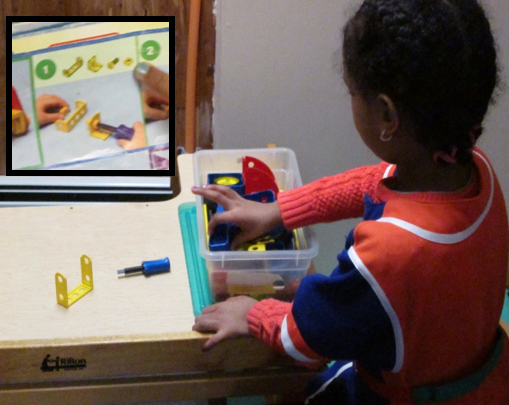Visual sequencing essentially incorporates the use of language skills as you talk yourself through a task. However the activity presented to this youngster incorporates a wealth of additional learning skills.

Visual Sequencing involves use of the concept “what comes next?” This is a vital reading readiness skill in that the youngster is required to mentally organize a series of visual images/letters along with their corresponding sounds to form words. During the preschool years, most schools are structured so that the youngster will have practiced pre-requisite mental tasks by manipulating blocks, crafts and other toys and will have learned to follow both spoken and pictorial instructions.

Other learning skills involved in this Jr. Erector activity include:
- Visual Discrimination Skills – the ability to separate out and select specific distinguishing features of each part needed. For example, the “U” shape bracket selected is too big, and was self corrected as the project continued.
- The ability to use both hands together – this skill is also called Bilateral Motor Integration. This skill is defined as being able to use one hand to hold a part still, while the other hand works with a corresponding part to the toy. For example, while building the “chair”, one hand holds the red triangle still to attach it onto the “U” shaped base, while the other hand uses the screwdriver to insert the bolt through the holes that secure the parts of the chair together.

This activity also introduces use of a hand tool that comes with its own inherent rules including :
- The need to grade the amount of force to be used .. how tight/loose to hold the pieces
- The need to separate the fingers of each hand in order to hold various sections of the toy (i.e. one hand must hold the nut still, while the other hand manipulates the screwdriver).
- Handedness: how to sequence positioning of the parts so that the dominant hand can act as the mobilizing force thus freeing the other hand to work as the stabilizing force


Comments are closed.